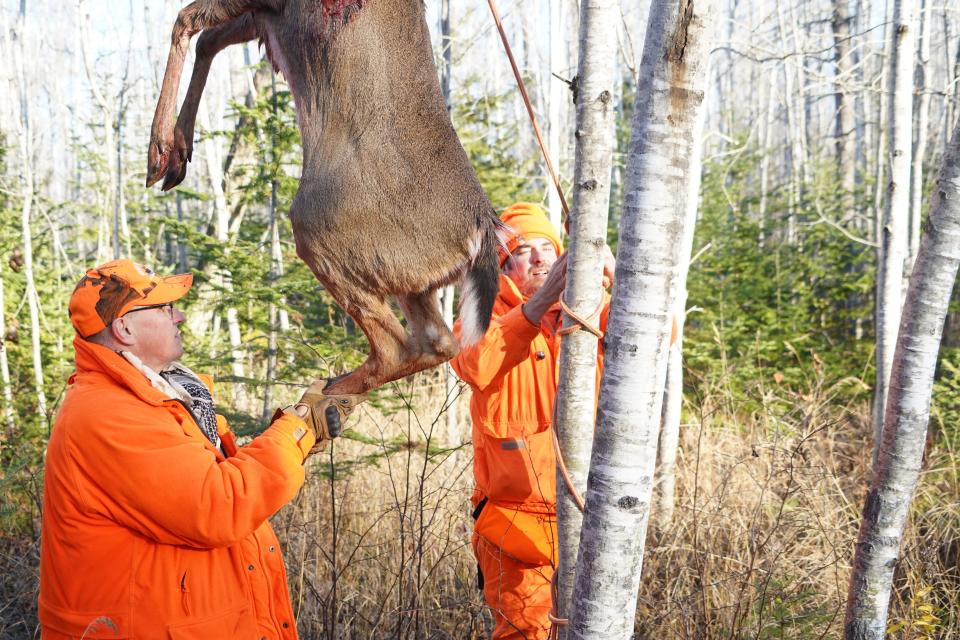Smith: Madeline Island deer hunt offers modern link to Apostle Islands' tradition

LA POINTE - On my travels north for the 2023 Wisconsin gun deer hunting season I passed many familiar landmarks with links to our official state wildlife animal and hunting.
There was the village of Deerfield in Dane County and Venison Drive, a Price County crossroad that always makes me smile.
St. Therese in Phillips was offering its annual hunters' mass and the huge, leaping buck statue along Highway 13 in Fifield once again served as inspiration to all hunters passing through town.
But I was headed for a new experience in territory farther north, in fact as far north as a hunter can go in Wisconsin: the Apostle Islands.
At the invitation of my friend Thor Stolen of Milwaukee, I'd be hunting a parcel he owns on Madeline Island.
It was the first time in my 45 Wisconsin gun deer seasons I'd be hunting off the mainland of the Badger State.
The directions called to take the road until it ended in Bayfield, then catch the Madeline Island Ferry to La Pointe.
Then a 15-minute drive on the island's main road to a dirt two-track and into Stolen's primitive camp.
"It's a long way but I always feel like it's worth it," Stolen said Nov. 18, opening day of Wisconsin's nine-day gun deer hunt.
Stolen respects traditions and values history. In fact he still refers to the 75-acre property he bought in 2017 as "Mike Anderson's Camp" after its previous owner and local resident.
This year six of us gathered to pursue deer and enjoy camaraderie on the heavily-wooded parcel. In addition to Stolen and me, there were: David Coles, a former Milwaukee resident who now lives in Culver City, California; Isak Stolen, Thor's brother who lives in Park City, Utah; Dan Sweeney of Glendale; and Paul Wilgreen of Bayside.
Jason Wallach of Whitefish Bay, a regular member of the group, missed this year as he was traveling in Egypt.
More: Hunters register 16% fewer deer over opening weekend of 2023 Wisconsin gun deer season
What are the Apostle Islands?
When it comes to Wisconsin deer hunting, the Apostle Islands don't host a large number of hunters but do have a rich tradition.
The Apostles are a twenty-two island archipelago in Lake Superior off the shore of the Bayfield Peninsula.
Twenty-one of the islands are in Apostle Islands National Lakeshore. But Madeline Island, the largest of the Apostles, is excluded; it includes a state park, a town park as well as the town of La Pointe. The land on the island is about half public and half privately-owned.

The first human hunters on the islands were Native Americans, especially the Ojibwe, still residents in the region.
Europeans later arrived in the area increased activity in fur trade, shipping, fishing, logging, quarrying, farming, and tourism, according to "People and Places: A Human History of the Apostle Islands," a 2008 publication written by Jane Busch.
Deer populations have wavered significantly in Apostle Islands
The Apostle Islands were intensively logged in the late 19th and 20th centuries and deer populations have fluctuated widely on the Apostle Islands over the last 100 years or so.
Several factors have been at play, including forage conditions, winter severity and remoteness.
After the big timber was cut on the islands, the regrowth, including poplar, red maple and aspen, provided ample food and the deer populations surged.
Since a boat (or ferry in the case of Madeline) is required to reach the islands some of the deer populations grew virtually unchecked with little to no hunting pressure.
In 1954, Rocky Island, about 2 square miles and among the smallest in the chain, was severely overpopulated with an estimated 400 deer, according to Sports Illustrated. A late fall 1954 hunt on Rocky by 40 hunters yielded 34 deer. The bucks in the harvest averaged 92 pounds, compared to a normal 140.
Among the hunters on Rocky that fall was Mel Ellis, former outdoors writer at the Milwaukee Journal and author of "Notes from Little Lakes."
The deer populations were reduced in subsequent years, both through winter kill and hunting, and in 1969 the total deer harvest in the outer islands was 18, according to an article by Tom Guyant in the Milwaukee Journal.
In 1970 all the islands were open to hunting except Madeline, where the deer population had been knocked down by higher hunting pressure.
The Madeline Island deer population has since recovered and annual hunting seasons are held.
The Madeline Island deer population was estimated at 700 animals after both the 2021 and 2022 hunting seasons, according to the DNR.
Last year hunters killed 88 deer on the island, including 62 bucks and 26 antlerless.
Stolen's group has contributed to the tallies. The recent deer harvest on his property included three bucks in 2021, several does and one very large buck last year taken by Wilgreen.

A spike buck, a few shots, but deer movement slow
We were all keen to find out what the 2023 season would hold.
Opening day dawned mostly clear with light winds and the sun painted the eastern horizon orange. But as with the rest of the state, even at Wisconsin's far northern latitudes there was no snow on the ground.
The woods were the same color as the deer's coats.
There was some deer movement early Saturday, though. At 7 a.m. at rifle shot rang out on property owned by Jim Risgaard, Stolen's neighbor.
Risgaard, a U.S. Army veteran, made good on the shot and put his tag on a spike buck.
About 7:30, Stolen spotted two fawns and an 8-point buck but wasn't able to connect on a shot.
I heard a single shot at 9 and another at 10:15 but that was it. Several of us came into camp for lunch; the general report was deer movement was slow.
We all ventured out to stands in early afternoon for the rest of the day as the mercury rose into the mid-40s.
With no wind and the sun drifting down through the poplars and maples, it was tempting to take a nap in the tree stand.
My only visitors were pine squirrels, hairy woodpeckers, white-breasted nuthatches and blue jays.
Coles, hunting about 400 yards away, had an ermine entertain him for about 45 minutes. The animal was already in its white winter coat.
Camaraderie and a spaghetti dinner
After shooting hours we piled in a car and headed to the Beach Club in La Pointe for the Hunters Game Feed, an annual tradition on Madeline Island.
We joined a packed house of about 100 people for a spaghetti dinner and fundraiser. The money raised from the $10 dinner and raffles is split between the Madeline Island Historical Preservation Association and local efforts to feed deer in winter, said Ann Lacey, MIHPA board member.
Each year the group issues a "hunter of the year" award.
Lacey showed me a 4-foot-tall trophy on the bar. A plaque on its front reads: "Annual Island Hunters Game Feed, Recognizing Sportsmanship, Integrity and Preservation Mindedness."
It's crowned by a large-antlered stag, and has fishing and hunting figurines on its second level. The front is covered with name plates of "hunters of the year."
The tradition is, I'm told, to rotate the honor between island residents and visitors.
This year Lee Jensen Bujold of Duluth receives the honor. She's not here in person but is part of a rich Madeline Island hunting history. Bujold is the third generation of island hunters in her family, following her great uncle Pokey Ellison and her father Tweet Jensen, and hunted deer here for more than 20 years.
Lacey read from a 2020 letter penned by Bujold in which she referred to the gun deer season as "holy week."
"That's the essence of this culture we have here, of island living and arts and self-sufficiency and community and deer hunting," Lacey said. "It's all part of a whole."
Members of several traditional deer camps were in attendance, including Richard Timm, 75, of Amery. Timm has hunted the Apostle Islands since the 1960s and used to join groups that would take a boat to the outer islands including Cat, Michigan and Stockton.
"It was an old 35-foot fishing boat and we'd get about 30 people on it for the hunting excursion," Timm said. "We'd drop almost everbody off on one end and then put a few standers on the other."
The deer drives were productive sometimes and other times not, Timm said.
"It was an adventure," Timm said. "But I think we do about as well now for deer as we did then."
Sunday dawned crisp and clear on Madeline. Once in the stands, the still conditions allowed us to hear anything approaching.
But the "crunch, crunch," near my stand was from only pine squirrels.
Sunday also passed without a shot for our group. The temperature reached 48 degrees; the conditions might have been better suited to golf.
However, there is value in time spent in the deer stand even when no deer are sighted.
"Hunting is one of the only times when I can sit free of distractions and just think and observe," said Stolen, a father, husband who works as associate professor of education at Alverno College.
And for star gazing nothing in the Midwest can beat Madeline Island. We spent the nights sitting around the campfire, telling stories and watching for meteors.
After quiet Sunday, fortunes change on final day
Monday afternoon things changed in the woods, though. There was more deer movement and Stolen made good on a shot on a doe.
Together with Risgaard's spike, we had two deer for our camp in 2023.
The animals were taken to a processor on Madeline to be cut up and made into steaks, roasts and sausage.
Our fortunes appeared to be par for the seasons. There were two dozen vehicles but no deer on the ferry going back to Bayfield.
But spirits were high in our deer camp. As we departed and traveled our various routes home, we were all grateful for the chance to travel to Wisconsin's northern reaches to experience Madeline Island's deer hunting tradition.
More: Wildlife advocacy group sues Wisconsin DNR over 2023 wolf management plan
More: Wildlife watching leads the way in USFWS national survey of outdoor activities
This article originally appeared on Milwaukee Journal Sentinel: Madeline Island deer hunt offers modern link to Apostle Islands' tradition

